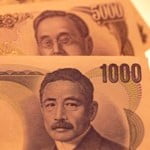
Evidently, none of the officials from West Germany, France, the United States, Japan, and the United Kingdom, who gathered at New York’s Plaza Hotel on September 22, 1985, knew they were letting the genie out of the bottle. Regrettably, once out, it’s near impossible to put back in.
By 1985, fourteen years after Nixon severed the last remnants of the linkage between the dollar and gold, floating currencies had resulted in grotesque distortions to the global economy. The U.S. dollar had appreciated 50 percent between 1980 and 1985 against the Japanese yen, West German Deutsche Mark, and British pound – the currencies of the next three largest economies at the time. American manufacturers could not compete with the dollar valued so much higher than its competitors. In addition, the U.S. trade deficit had ballooned to 3.5 percent of GDP as foreign imports became vastly cheaper for American consumers.
The Plaza Accord sought to devalue the dollar to bring global trade back into balance. Moreover, the Plaza Accord was the first time central bankers executed a coordinated intervention into currency markets and the global economy took prominence over national sovereignty. While the Plaza Accord may have obtained its objective – the dollar declined by 51 percent against the yen between 1985 and 1987 – magnificent, unintended consequences bubbled up in Tokyo.
The Bank of Japan combated the recessionary effect of the strengthening yen by cheapening the price of credit. These expansionary monetary policies resulted in the massive Japanese asset price bubble of the late 1980s. By 1989 property in Tokyo’s Ginza district sold for $20,000 per square foot. By 2004 prices had fallen over 90 percent. The stock market bubble and bust was equally absurd…
An Ominous and Profound Symbol of things to Come
In September 1985, at the time of the Plaza Accord, the Nikkei 225 traded for about 12,667. By December 29, 1989, the Nikkei 225 closed at 38,916…up over 207 percent. Yesterday it closed at 10,824…down 72-percent even more than 23-years later. The unfortunate souls who bought stocks in December of 1989 and held on to them will see most of their adult lives pass by before getting back to even – if ever.
After Japan’s asset prices blew up, Japan’s economy went into a multi-decade slump. Despite mammoth amounts of government stimulus and deficit spending Japan’s economy has stagnated. Initially no one could’ve known how bad things would get. But early on, for the shrewd observer, there were gloomy warning signs for everyone to see…
For example, on January 8, 1992, following the pop of Japan’s protracted credit induced asset bubble, President George H.W. Bush, while visiting in Japan, leaned over to Prime Minister Kiichi Miyazawa, perhaps to whisper some vital Yankee secrets for orchestrating a financial bailout. Then, in an ominous and profound symbol of things to come, he barfed on his lap.
Japan’s economy has yet to recover. In effect, Japan’s economy has continued to throw up all over itself. If you didn’t know it, Japan’s government debt is 230 percent of GDP, the largest percentage of any industrialized nation in the world. By comparison, the government debt to GDP ratio of the United States is 103 percent. Different than the United States, however, Japan has financed its debt domestically.
The way Japan has been able to get by without borrowing from foreigners is through its positive trade balance. By exporting more than they import Japan’s population could use their proceeds to support their government’s budget gaps. But those days may have come to an end…
Currency Wars and the New Age of Desperation
In 2011, Japan ran a trade deficit for the first time since 1980. What’s more, Japan’s trade deficit for 2012 widened to $78 billion. If this keeps up Japan will have to turn to foreign investors to finance their government debt. Naturally, foreign investors will demand higher compensation than the current 0.75 percent yield on the 10-Year Japanese bond.
So the solution to Japan’s problem is to do the opposite of the Plaza Accord. It must devalue its currency and boost its exports. Of course, other exporters are sensitive to these sorts of things.
Shinzo Abe was recently elected Prime Minister of Japan. No doubt, he’s just landed himself the worst job in the world. He has the unfortunate position of governing a nation that’s economy and finances are fundamentally doomed.
Consequently, Abe must do the only thing he can do. He must inflate. Last week, following pressure from Abe, the Bank of Japan announced that it will be launching an open-ended asset purchase plan and a 2 percent inflation target. On top of that Abe has let the yen fall 15 percent against the dollar over the last two months.
By the end of last week finance ministers from Germany, China, the United Kingdom, Russia, and Thailand were grumbling that Japan’s yen devaluation could lead to a currency war where exporting nations attempt to devalue their currencies to attain a competitive advantage over other countries.
The more economies sputter the more governments, and their central banks, will pursue prosperity through ruining their currencies. In the new age of desperation, the race to the bottom is on.
Sincerely,
MN Gordon
for Economic Prism
Return from Currency Wars and the New Age of Desperation to Economic Prism






Pingback: The Great Money Caper